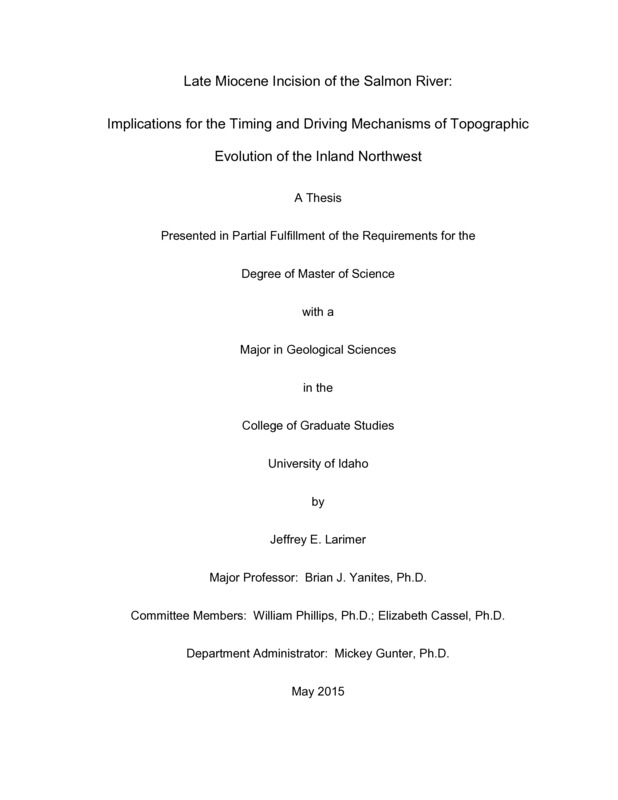Late Miocene Incision of the Salmon River: Implications for the Timing and Driving Mechanisms of Topographic Evolution of the Inland Northwest
Larimer, Jeff E. (2015). Late Miocene Incision of the Salmon River: Implications for the Timing and Driving Mechanisms of Topographic Evolution of the Inland Northwest. Theses and Dissertations Collection, University of Idaho Library Digital Collections. https://www.lib.uidaho.edu/digital/etd/items/larimer_idaho_0089n_10603.html
- Title:
- Late Miocene Incision of the Salmon River: Implications for the Timing and Driving Mechanisms of Topographic Evolution of the Inland Northwest
- Author:
- Larimer, Jeff E
- Date:
- 2015
- Keywords:
- delamination erosion geomorphology Salmon River topography Yellowstone
- Program:
- Geology
- Subject Category:
- Geomorphology
- Abstract:
-
Throughout the tributaries of the Salmon River watershed, there is an observable break in slope that separates low relief (<400m deep valleys) headwaters from the high relief (1200-1600m deep valleys) main stem of the Salmon River gorge. This transience was triggered by baselevel lowering along the Salmon River sometime during the late Cenozoic. However, the timing of the incision is unknown as is the mechanism that caused it. To provide insight into the drivers of landscape evolution in this region, we integrate field data with numerical modeling to constrain the timing of incision and gorge formation. We present 10Be cosmogenic radionuclide concentrations from bedload sediment in ten different tributaries of the mainstem Salmon located between the South Fork and Riggins, ID. The samples record basin wide erosion rates ranging from ~0.05 mm/yr in low-relief topography to ~0.12 mm/yr in high-refief topography over the last 103-104 yrs. We use these erosion rates together with slope-area regression analysis to calibrate a 1D river incision model for rivers draining the Idaho Batholith rocks. After a suite of model runs we perform a best-fit analysis to constrain the timing and rate of baselevel change. The results suggest an increase in the incision rate of the Salmon River occurred roughly 8-10 Ma and has continued at a persistent rate. These results combined with other long-term exhumation rates of the region are consistent with a hypothesis that the increase of incision was initially driven by lithospheric delamination facilitated by the Yellowstone plume and then maintained by drainage capture following migration of the continental divide.
- Description:
- masters, M.S., Geology -- University of Idaho - College of Graduate Studies, 2015
- Major Professor:
- Yanites, Brian J
- Committee:
- Phillips, William; Cassel, Elizabeth
- Defense Date:
- 2015
- Identifier:
- Larimer_idaho_0089N_10603
- Type:
- Text
- Format Original:
- Format:
- application/pdf
- Rights:
- In Copyright - Educational Use Permitted. For more information, please contact University of Idaho Library Special Collections and Archives Department at libspec@uidaho.edu.
- Standardized Rights:
- http://rightsstatements.org/vocab/InC-EDU/1.0/

